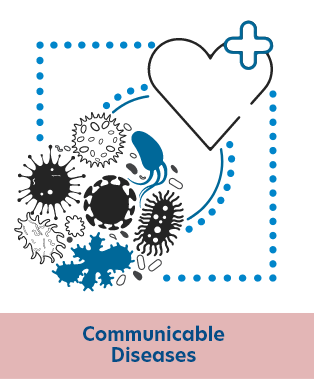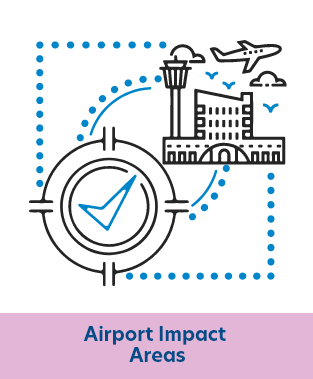
Who Is This Resource For?
Airport Staff
The aviation industry has a long-standing commitment to safe and efficient operations. A layered approach to safety and security at each step of the passenger journey and in airport operations helps to reduce risk to passengers, employees, and properties. The aviation industry, including ACRP, has examined the impacts of communicable diseases on airport operations in the past. Most notably, ACRP Synthesis 83: Preparing Airports for Communicable Diseases on Arriving Flights1 reviewed experiences from six different outbreaks, categorized the various findings, and outlined future research priorities. The Government Accountability Office’s (GAO) Report GAO-16-127 previously articulated the roles and responsibilities of relevant agencies in response to communicable diseases in an airport environment.2 Despite these efforts, COVID-19 exposed critical gaps in pandemic preparedness in the aviation industry and raised key concerns regarding organizational structure, planning, and operations of airport facilities.
Because of their functional role as a nexus for collecting and distributing travelers, airports have been called upon to implement health checks, quarantines, and other procedures for managing the flow of inbound and outbound passengers. In the past, these have been deployed primarily at major airports, focusing on international rather than domestic travelers. The COVID-19 public health emergency introduced new questions about interstate travel and domestic health and safety checks that neither public health experts nor airports could entirely answer. COVID-19 also introduced a new scale of operational need to protect health and wellness across the entire passenger journey. While efforts in the past may have focused on immigration or been directed at specific functions of the airport, COVID-19 required an equivalent level of response and consistency across the entire airport system.
Airports generally have clear roles and responsibilities for emergency response situations across airside operations, emergency personnel, and airport leadership. COVID-19, however, was not a typical emergency. Due to the critical impact on passengers in the terminal, departments had to be engaged in new ways with passenger services, tenants, and terminal operations. In response to COVID-19, airports worked rapidly to maintain operational flexibility in order to address public health guidelines. The guidelines provided in this WebResource incorporate any evaluations of the efficacy of these new procedures, codifying which should be retained.
Within the airport, airside and landside operations are complemented by organizational verticals, such as customer experience, commercial properties, public safety, facilities/maintenance, and communications, which all must work together effectively. During the COVID-19 pandemic, airport personnel were asked to continue core functions despite a reduction in staff numbers and very real fears of becoming ill or infecting a loved one. Airports needed to take responsibility for the well-being of the individuals working in the airport environment but had little advice on how to do so. Along with new approaches to logistics, such as enforcing physical distancing, keeping seats open, and separating staff from the traveling public as much as possible, airports made efforts to provide personal protective equipment (PPE) to their workers despite being unfamiliar with disposable medical supply providers and the intense competition for these limited products. Airports also needed to provide regular guidelines to their employees—a daunting task in a sea of ever-changing information. Anecdotally, airports relied on informal means of communication with colleagues at other airports, trade organizations, and their professional networks to share information. This WebResource consolidates the collected experiences of airport staff and other stakeholders involved in these efforts for the benefit of anyone who seeks similar guidelines.
Stakeholders
Stakeholders directly involved in airport and airline operations as they relate to infectious disease preparedness and response (particularly COVID-19 impacts) include airport authority leadership, airport planning personnel, and management involved in infectious disease planning. Third-party stakeholders are critical to the operation of the airport but may not be under direct management of the airport, introducing additional challenges during a pandemic response. These stakeholders may include airlines, terminal operators, government agencies [e.g., the Transportation Security Administration (TSA), Customs and Border Protection (CBP), and the Federal Aviation Administration (FAA)], concessionaires, service providers, and ground handlers. These organizations all have critical operational roles to play in promulgating policies and procedures, providing appropriate operational support, and upholding specific standards that the airport may set during a pandemic response.
Federal State and Local Governments
Airports highlighted the importance of meeting with federal and state government authorities to better respond to the pandemic in a consistent and more unified manner. These efforts included meeting virtually with city leaders and officials, participating in city-wide communications, and attending sponsored Department of Homeland Security (DHS) calls. The discussions enabled information sharing about the spread of the virus and pandemic mitigation measures to help airports and local authorities better plan and prepare for the response. Airports should consider developing a team or identifying a point of contact that communicates regularly with government representatives, including the World Health Organization (WHO) and other public health organizations, to better anticipate public health incidents and provide informational materials to first responders.
Communicating frequently with the local, state, and federal government agencies, as well as public health and aviation organizations helps airports better understand and stay informed of the policies and procedures for a communicable disease response. During steady state operations or a communicable disease outbreak, having a working relationship with governmental, non-governmental, and medical entities will help the airport authorities ensure they are obtaining the most reliable information about local disease threats, modes of transmission, and mitigation best practices.
Airports that already had developed strong relationships with the FAA, CBP, and TSA mentioned that these relationships were instrumental in helping guide them during the initial phases of the COVID-19 pandemic. Although only a couple of airports had a Center for Disease Control and Prevention (CDC) representative onsite to provide advice, it was noted that sharing information about the value of such representatives during calls with the American Association of Airport Executives (AAAE) or Airports Council International (ACI) was useful to other airports. Airports that already had developed relationships with their local fire department, local hospitals, and law enforcement felt they were in a better position to provide medical services and supplies to their customers, employees, and tenants.
Communicating with state and local health officials, as well as federal entities such as the CDC, is also important for airports during public health emergencies. Some airports dedicated a liaison employee to maintain communication with the local, state, and federal health agencies during the pandemic, while others brought in medical doctors and experts in epidemiology from local medical facilities to communicate risks and best practices to their staff. During a 2019 ACRP Insight Events Presentation, Dustin Jaynes, Public Health Administrator and Chief Epidemiologist at Dallas/Fort Worth International Airport (DFW), explained how DFW used health education materials developed by the CDC to inform first responders about the Ebola virus disease’s transmission modes and how to recognize the preliminary symptoms of the disease.3 The airport also consulted with expert medical professionals, Doctors Without Borders, public health agencies, the WHO, and other organizations to provide informational materials to first responders.
Communicating frequently with the local, state, and federal government agencies, as well as public health and aviation organizations helps airports better understand and stay informed of the policies and procedures for a communicable disease response. During steady state operations or a communicable disease outbreak, having a working relationship with governmental, non-governmental, and medical entities will help the airport authorities ensure they are obtaining the most reliable information about local disease threats, modes of transmission, and mitigation best practices.
Public Health and Medical Professionals
The Global Biorisk Advisory Council (GBAC) is a division of the International Sanitary Supply Association, a worldwide cleaning industry association, which partnered with AAAE to deploy a program within U.S. airports. The overall program is not unique to the airport sector but focuses on helping organizations and businesses prepare for, respond to, and recover from biological threats and biohazard situations. The GBAC StarTM is the cleaning industry’s only outbreak prevention, response, and recovery accreditation for facilities. Currently, there are a total of 105 U.S. airports that have achieved the GBAC Star accreditation and forty airports that are in the process of obtaining the accreditation. GBAC Star accreditation determines that a facility has established and is maintaining a cleaning, disinfection, and infectious disease prevention program to minimize risks associated with infectious agents like COVID-19. It also ensures the proper cleaning protocols, disinfection techniques, and work practices are in place to meet any biosafety challenges. Facilities prepare submission documentation in line with the GBAC handbook; the GBAC Council reviews the documentation for compliance and, if successful, grants accreditation subject to annual review. AAAE and its members collaborated with the GBAC Scientific Advisory Board to develop a GBAC Airports Guidance Handbook that advises airport staff on best practices to combat biohazards and infectious diseases.
Aviation Organizations
ACI accreditation assesses the airport’s health policies to ensure they are in line with the COVID-19 Business Recovery guidelines and the International Civil Aviation Organization (ICAO) Council Aviation Recovery Task Force (CART) standards. The ACI-World Airport Health Accreditation (AHA) Program is a voluntary, industry-specific self-assessment that focuses on airport-specific operations. Those operations include airport cleaning and disinfection, physical distancing, signage, communication, and facilities based on ICAO CART topics.4 To apply, the airport completes a self-assessment, followed by an online ACI validation interview with key personnel. Recommendations are made for improvement or accreditation is awarded for the next 12 months. Ongoing accreditation relies on continuous improvement and evidence-based self-assessment submissions. Currently, over 400 airports are accredited globally for the ACI World AHA accreditation.
Traveling Public
Passengers and the general public use airport facilities every day and all planning should recognize how the customer experience plays into passenger volume. After the onset of COVID-19, fear of infection reduced air travel to lows that had not been seen since immediately following 9/11. Businesses inside of, and dependent upon, airports, such as car rental agencies, restaurants, and hotels, all saw corresponding reductions in revenue. The financial impact of the interruption cascaded throughout many local economies, adversely affecting many businesses with only indirect ties to air travel. In order to rebuild these systems, customer confidence in the safety of air travel must be restored.
While commercial airline activity is improving, there is some speculation that business travel may not rebound as strongly as personal or tourism travel due to how businesses responded to the COVID-19 lockdowns with remote work, conference calling, and other measures. In contrast, general aviation airports have recently reported increasing traffic, which may indicate a shift in the mode of business travel toward increased usage of charter and corporate aircraft.
Restoring the confidence of travelers regarding safety from a health perspective is going to be partly dependent upon how passengers perceive the experience going forward. The airport experience has changed drastically from new health protocols to reduction in food options and heightened screening. Airports will require guidelines on simultaneously responding to communicable diseases without negatively impacting the customer experience, even when ancillary businesses downsize operations.
[1] Smith, James F. and Greenberg, J. (2017). ACRP Synthesis 83: Preparing Airports for Communicable Diseases on Arriving Flights. Transportation Research Board, Washington, DC. https://doi.org/10.17226/24880
[2] GAO. (2015). Air Travel and Communicable Diseases: Comprehensive Federal Plan Needed for U.S. Aviation System’s Preparedness. https://www.gao.gov/products/gao-16-127
[3] Wilhelmi, J. (2019). Conference Proceedings 55: Airport Roles in Reducing Transmission of Communicable Diseases. Summary of a Workshop of the Airport Cooperative Research Program’s 2018 Insight Event. Transportation Research Board, Washington, DC. https://doi.org/10.17226/25367
[4] ICAO. (2020). Council Aviation Recovery Task Force Report. Retrieved February 1, 2021, from https://www.icao.int/covid/cart/Documents/CART%20Report%20Final.pdf
Banner image credit: Unsplash



